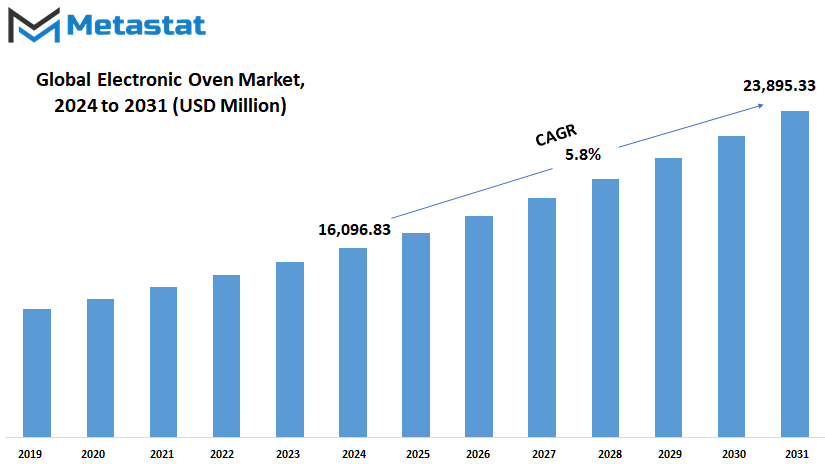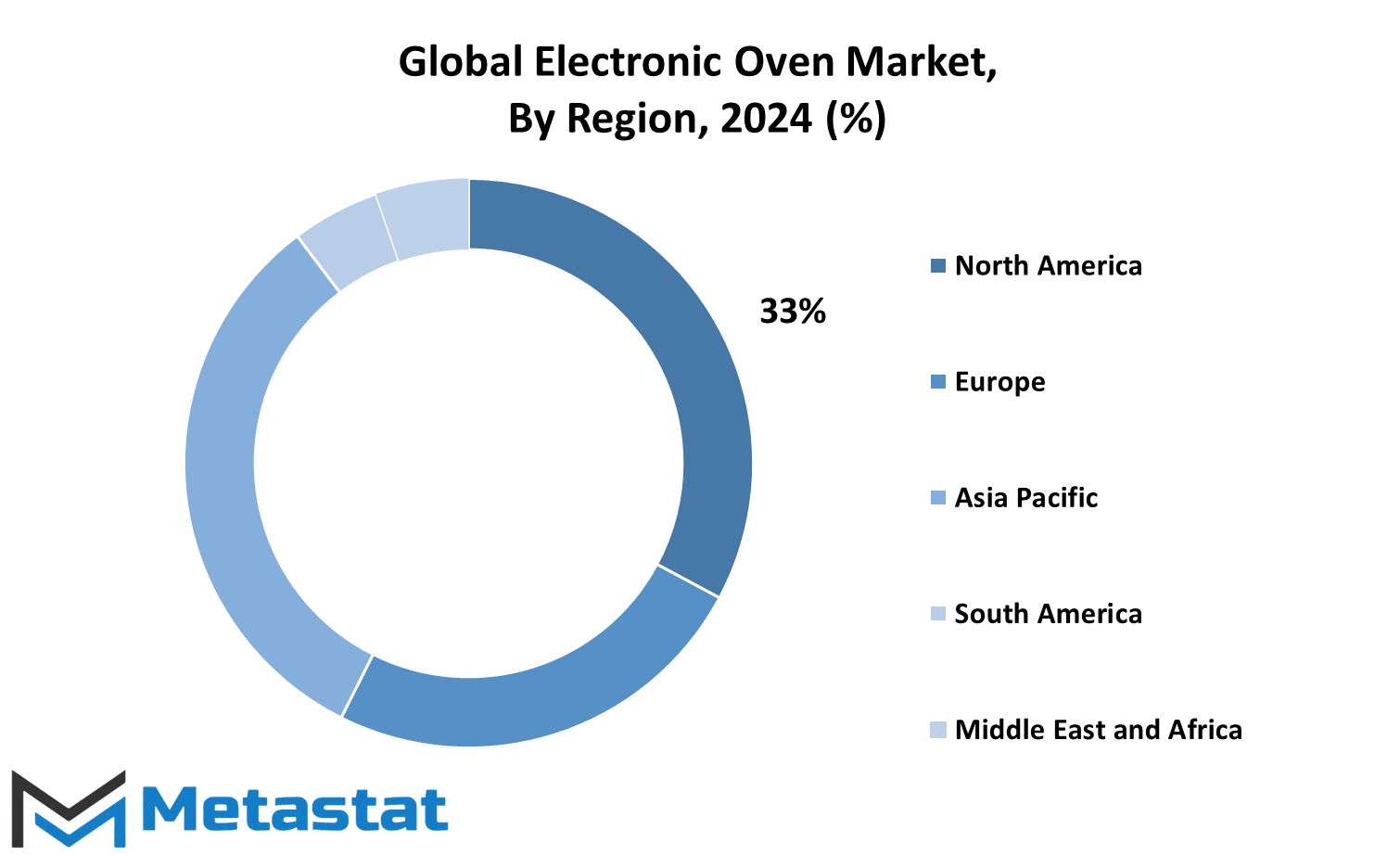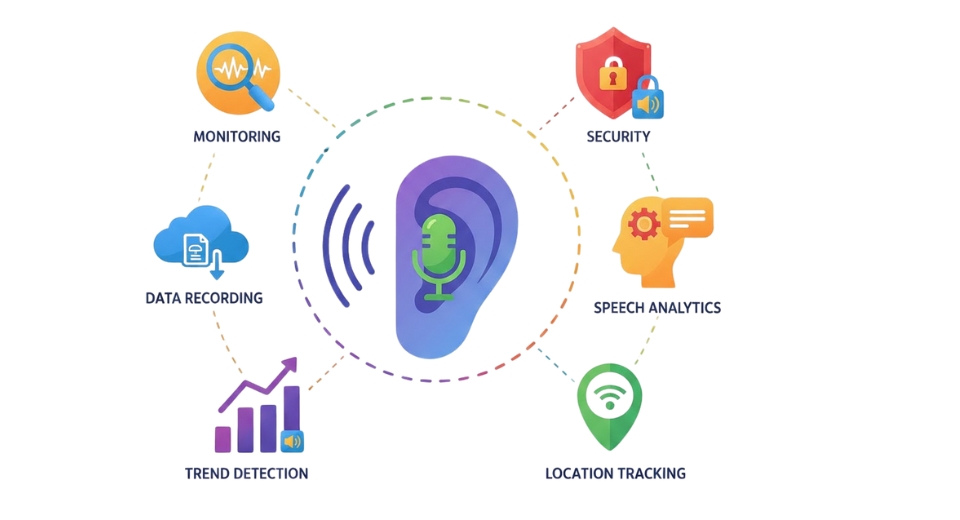MARKET OVERVIEW
In the midst of all this, the global Electronic Oven market refers to an even more focused section of global home appliances production involving innovation and manufacturing in order to provide electronic ovens with leading-edge electronic controls, as well as features for electronic ovens. Such oven units, coupled with the innovations of technology, changed the world of culinary arts and techniques that applied inside and outside homes. This market has been the basis for efficient, precise, and user-friendly cooking solutions as the evolution of technology and its changing definitions of modern living evolve.
The electronic ovens basically differ from the traditional models in the aspect that they have electronic control systems improving the precision of temperature management, modes of cooking, and timer functions. The electronic control system brings about flexibility by allowing a multitude of methods: baking, grilling, roasting, etc. There exist various end users, like the household, restaurant, and processing units for foods, with every one having particular features due to their different kind of cooking methods.
The global electronic oven market will lean towards convenience and automation based on changing consumer lifestyles. Manufacturers will focus on smart technologies such as IoT connectivity, voice-controlled operation, and application-based monitoring. It enhances the user experience at the same time makes electronic ovens a part of a smart kitchen product that will capture the attention of the more tech-savvy consumers in the global market.
The geographical scope of the Global Electronic Oven market is vast, encompassing regions like North America, Europe, Asia-Pacific, and emerging economies. Each region has unique preferences and challenges shaped by cultural culinary practices, economic conditions, and technological adoption rates. For instance, while North America and Europe will focus on high-end features and sustainability, the Asia-Pacific region will demand affordability along with performance, given its diverse consumer base.
Emerging market trends are toward energy efficiency and environmental sustainability. The manufacturers are expected to pursue the environment-friendly material and energy-efficient technology to abide by the stiff environmental laws as well as increasing consumer awareness over the issue. This will make new ovens based on newer techniques of insulation, lower power consumption, and compatibility with renewable energy sources.
The distribution channels for electronic ovens are changing fast, and e-commerce is increasingly becoming the dominant mode. Traditional retail outlets will remain the most important touchpoints, but online platforms will allow wider reach, especially in regions where physical retail penetration is still limited. This shift toward digital sales channels will allow manufacturers to access previously underserved markets and offer personalized shopping experiences.
The Global Electronic Oven market will continue to remain aggressive in its competitive dynamics because the leaders in the market and new entrants will continue to battle for share through innovation and branding strategies. Further enrichment in the product landscape will come from technology firms and appliance manufacturers combining to develop more advanced functionalities at competitive price points.
In conclusion, the Global Electronic Oven market will revolutionize modern cooking with emphasis on technology-driven solutions, energy efficiency, and regional adaptability. As the expectations of the consumers evolve, the market will embrace innovation in order to produce products that cater to the current demands, hence ensuring its continued relevance and growth in the coming years.
Global Electronic Oven market is estimated to reach $23,895.33 Million by 2031; growing at a CAGR of 5.8% from 2024 to 2031.

GROWTH FACTORS
The Global Electronic Oven market will be witnessing immense growth in the following years. It is being supported by immense shifts in consumer preferences and advances in technology. Along with increased urbanization, modern kitchen appliances are gaining popularity because they save time and increase convenience. Electronic ovens, thus, help simplify cooking processes and save effort; therefore, electronic ovens are an indispensable part of any modern household. This trend is further supported by the growing demand for energy-efficient smart ovens that have automated cooking settings, precise temperature control, and touch interfaces.
The most important drivers for this growth are the worldwide demand for energy-efficient and eco-friendly solutions. Nowadays, more consumers are getting aware of the consumption of energy and how it is affecting the environment. People have begun to seek ovens that have a lesser power consumption while at the same time giving off excellent performance. This has resulted in the invention of newer models with modern technology like inverter heating and low-power standby modes by the producers.
On the other hand, there are potential challenges that would limit the growth of the Global Electronic Oven market. It is a cost-prohibitive product for a number of people because the prices of advanced electronic ovens compared to traditional types are relatively very high. Their adoption in the rural areas has also been hampered by power supply and a lack of necessary infrastructure. Despite these challenges, the market still has much potential, and this is encouraged by the constant efforts to make these appliances more accessible and affordable.
One of the most promising opportunities is IoT technology and smart home connectivity in electronic ovens. These innovations allow users to control and monitor their ovens remotely using a smartphone or voice assistant, providing unmatched convenience and customization. For example, intelligent ovens can learn the preferences of users, provide recipes, and adjust themselves based on settings. This is sure to completely alter the way people cook. Hence this level of personalization will attract more consumers in the future.
Therefore, technological advancements will lead to a burst of innovation and adoption in the global Electronic Oven market. Sure, such constraints as cost and infrastructure need to be worked through, but in the future, it's quite conceivable that their growth can become more significant-with perhaps greater shifts towards smarter, more efficient, environmentally friendly kitchen solutions. The technological and urbanistic tendencies are a major opportunity for the market in shaping kitchens for the future.
MARKET SEGMENTATION
By Type
The Global Electronic Oven market is expected to grow significantly due to technological developments and changing consumer preferences in cooking appliances. Efficient, versatile, and energy-saving solutions for households and commercial establishments are increasingly becoming the need of the hour, and electronic ovens are seen to be meeting these demands. It is expected to dominate the kitchen appliance sector in the coming years. These ovens come in various types, catering to the different needs of consumers and continuously innovating with regards to features and functionality. By type, the market comprises convection ovens, microwave ovens, combination ovens, and conventional ovens, each for a different purpose.
Convection ovens are designed to circulate hot air evenly, which results in consistent cooking. These ovens are preferred by those who value precision and speed in their cooking process. Microwave ovens, however, continue to be popular because of their unmatched convenience and the ability to heat or cook food quickly. With technological advancements, newer microwave models now come with enhanced functionalities such as sensor-based cooking and energy efficiency, making them more appealing to a wider audience. Combination ovens represent an integration of the convection as well as the microwave, ensuring that a better quality is yielded from each oven. Their efficiency in baking and grilling the food also renders them convenient enough for a frantic lifestyle.
Thus, in increasing demand for multi-function home appliances, combinations ovens may gain more acceptance and penetration into this market. Although traditional in design, conventional ovens continue to be popular due to their reliability and affordability. These have always attracted consumers who do not like the fuss of modern cooking techniques, both in the household and business spheres. Prospective
For the future of the Global Electronic Oven market, trends related to smart technology integration, designs that are ‘eco-friendly, and demand for premium cooking appliances are the forces that seem promising. In response to the consumer’s quest to connect ovens to a smart home, manufacturers have devised ovens where remote monitoring and controlling of cooking could be achieved by users. Secondly, with concern for the environment, consumers prefer energy-efficient ovens. The global electronic oven market is evolving and becoming more aligned with the needs of modern consumers. As innovative technologies continue to emerge and advance, this market is expected to experience steady growth as diverse options to enhance culinary experiences around the globe are introduced.
By Installation Type
The global electronic oven market has significant growth ahead, with technologies constantly transforming the modern kitchen as well as altering consumer preferences and demanding convenience along with energy efficiency. The diversity of consumers within this market helps offer various products for individual purposes and lifestyles. An important growth factor is an increasing dependence on household appliances for easier completion of everyday tasks. With families and individuals getting busier by the day, the need for time-saving appliances, such as electronic ovens, is growing steadily.
Based on installation type, the global electronic oven market is divided into built-in and freestanding options, which cater to the distinct preferences of customers. Built-in ovens have gained popularity due to their seamless integration into kitchen designs, allowing homeowners to maintain an organized and stylish cooking area. These ovens are particularly appealing in urban spaces where maximizing space utilization is essential. In contrast, freestanding ovens remain a reliable choice for those seeking flexibility in placement. Their portability and ease of installation make them a preferred option for renters or those frequently redesigning their kitchen layout.
The global electronic oven market is likely to witness a surge in innovative features. The latest trend of smart ovens, equipped with IoT technology, enables users to control cooking settings from mobile devices. This degree of connectivity does not only add to the convenience of the user but also brings the possibility of customized cooking. Features such as voice control, recipe suggestions, and automatic updates will become a standard feature catering to the tech-savvy generation. There is also the consideration of sustainability, which is increasing in the market.
Manufacturers have been focusing on producing energy-efficient models that match the global goals for the environment. Consumers have been opting for ovens that are eco-friendly, such as those with low power consumption and advanced insulation technologies. These choices indicate a shift in priorities toward reducing the carbon footprint associated with household appliances.
Electronic ovens are more accessible to the masses due to the emergence of e-commerce sites. Online shopping sites offer thorough comparisons of the products and customers’ reviews for the buyer’s decision-making. This convenience coupled with competitive prices and discounts accelerates market growth.
In conclusion, the global electronic oven market is expected to boom as it evolves to changing consumer needs and technological changes. With built-in and freestanding options catering to diverse needs, the market promises to transform how people cook, blending style, functionality, and innovation for years to come.
By Distribution Channel
The Global Electronic Oven Market will experience high growth as technology progresses and consumers tend to be interested in convenient, efficient appliances. In modern households and commercial kitchens, electronic ovens are a staple of precision temperature control and versatility. The increasing need for innovative solutions in cooking is driving the growth of this market, focusing on energy efficiency, smart connectivity, and easy-to-use functions.
An increasing number of distribution channels has played a vital role in boosting growth in the Global Electronic Oven Market. Online retail, for example, has gained considerable popularity, particularly since most consumers now consider it the preferred method for ordering products online as one can compare prices, read extensive reviews, and more. On these e-commerce websites, consumers find numerous alternatives accompanied by discount rates and fast delivery services. This trend, however, remains popular among young consumers who highly value the savings of time and effort to purchase appliances through online means. Online retail, in addition, allows producers to reach international markets, overcome geographical boundaries, and break into new markets.
Offline remains an important element of the market. Traditional brick-and-mortar stores allow customers to physically examine products, which is an important factor for those who prefer to assess an appliance’s build quality and features in person before purchasing. Stores often provide the opportunity to interact with knowledgeable sales staff who can answer questions and provide demonstrations. Offline retail also caters to individuals who are less comfortable with online shopping or prefer immediate purchase without waiting for delivery. As a result, online and offline channels of distribution have become necessary to provide electronic ovens to different kinds of customers.
Going ahead in the future, the global electronic oven market is also likely to become innovative due to increasing demand by consumers for intelligent appliances. Most features such as connectivity with the home automation system, voice control, and better saving energy are most likely to form product designs in the near future. These innovations are attractive not only to tech-savvy customers but also align with global sustainability goals. Additionally, as digital transformation is further extended, online retail platforms are expected to become even more sophisticated by offering virtual reality tools for product visualization and interactive customer support.
The Global Electronic Oven Market offers promising prospects where growth is boosted by the interplay of balanced online and offline channels. With time, technology shapes consumer preferences. Thus, this market is ready to witness dynamic growth in the following years.
By End-Users
The Global Electronic Oven Market, to be brief, seems destined for a healthy change because of the emergence of new technologies and shifting preference patterns. Throughout the years, electronic ovens have assumed a somewhat necessary profile for kitchens, both in residential and commercial users. However, with the increasing urge toward convenient lifestyles and constant growth in urbanization, its demand steadily increases across the globe.
The electronic oven is a package that is unrivaled for residential users, combining efficiency and ease. Today’s homes, especially in cities, look for appliances that will save them time and energy but will always produce reliable results. Such features as smart controls, energy efficiency, and multi-functionality are now part of the expected standard. Increasingly, consumers are attracted to ovens that can integrate easily with other smart devices, enabling control and monitoring from anywhere. This trend is anticipated to continue because more and more consumers embrace smart home ecosystems.
In the commercial sector, electronic ovens in the global market are gaining a lot of interest from hospitality, food service, and catering sectors. Commercial buyers focus on dependability, quickness, and capacity. Bulk food preparation operations need ovens that can deal with high capacities without compromising the quality of products. More modern models with programmable settings, self-cleaning capabilities, and accurate temperature management are becoming trendy. As businesses strive to enhance customer satisfaction and streamline operations, they are investing in cutting-edge electronic ovens to stay competitive.
The future of the global electronic oven market is likely to be shaped by sustainability. Governments and organizations around the globe are underlining energy-efficient solutions to reduce carbon footprints. Manufacturers are responding to the changing times by developing ovens that consume less power, use eco-friendly materials, and support sustainable practices. Advanced insulation, low-energy cooking modes, and compatibility with renewable energy sources will become key differentiators.
Another factor influencing product design and functionality is the health-conscious consumer. Many electronic ovens today are designed to accommodate healthier ways of cooking, such as steam-assisted baking and air frying. All these developments seem to fit the larger trend of well-being, yet convenience.
With technological advancement in the sector, the electronic oven market globally will expand. As such, driven by innovation and sustainability as well as a design that puts people first, it will look forward to having an expanding business with users around the globe for both residential and commercial applications.
|
Forecast Period |
2024-2031 |
|
Market Size in 2024 |
$16,096.83 million |
|
Market Size by 2031 |
$18,357.84 Million |
|
Growth Rate from 2024 to 2031 |
5.8% |
|
Base Year |
2022 |
|
Regions Covered |
North America, Europe, Asia-Pacific Green, South America, Middle East & Africa |
REGIONAL ANALYSIS
The global electronic oven market has witnessed a huge growth trend over the years due to advancements in technology, changes in consumer lifestyles, and the demand for energy-efficient appliances. With modernization of cooking methods within households and businesses, electronic ovens have become essential tools due to their convenience, precision, and versatility. An in-depth study of this market's geographical distribution shows interesting patterns and future opportunities that could shed light on how various regions contribute to its expansion.
The market is well-established in North America. The United States, Canada, and Mexico are the key contributors to the market. The high demand in this region can be attributed to the advanced infrastructure, wide use of smart appliances, and population that values saving time in their daily lives. With the continuous development of features like touch control, voice assistance, and Wi-Fi-enabled ovens, North America is expected to maintain its significant share in the market, adapting to the preferences of increasingly tech-savvy consumers.
Europe follows closely, with countries like the UK, Germany, France, and Italy leading the charge. European consumers emphasize energy efficiency and eco-friendly practices, prompting manufacturers to innovate with features that align with sustainable goals. For instance, ovens with enhanced insulation, automated power-saving modes, and eco-friendly manufacturing processes have gained popularity. As governments across Europe push for stricter energy consumption standards, this market is poised for steady growth, catering to consumers who prioritize environmentally conscious choices.
Asia-Pacific is growing as a significant market due to the burgeoning economies of India, China, Japan, and South Korea. The rising middle class, increasing urbanization, and disposable incomes have accelerated demand for electronic ovens in the region. The cultural shift of modern cooking appliances in urban houses is also adding to the rate of adoption. The sheer population size and rapid technological advancements suggest that Asia-Pacific will play a pivotal role in shaping the future of this industry.
Regions to tap further in include South America and Middle East & Africa. For the case of South America, economies and economies like Brazil and Argentina have growth tendencies based on increasingly stable economies, enhanced understanding about developed appliances like this for preparing better dishes, while Middle East & Africa witness improvement among Egyptian, South Africa, and various countries under GCC regions where infrastructure improvements along with enhanced disposable income spur consumers' ability to be adopters.
Each region contributes uniquely to the global electronic oven market, which emphasizes the need for localized strategies from manufacturers. The market for electronic ovens has great possibilities for growth in all regions when looking at the trend of ongoing technological advancements in global markets.

COMPETITIVE PLAYERS
Of late, the Global Electronic Oven market has shown tremendous changes, that are brought about by technological advancements and shifting consumer needs. In light of the increasing demands of convenience and energy efficiency, this market is expected to develop in a major way, opening up the floodgates for even the most veteran companies as well as new entrants. On innovation, sustainability, and stiff rivalry between top market players, the future of this industry depends.
The Global Electronic Oven market is dominated by major players like LG Electronics, Samsung Electronics, Whirlpool Corporation, and Electrolux AB, who set the standard for the others by their futuristic designs and features. These companies invest heavily in R&D for releasing smart ovens with Wi-Fi connectivity, touch-screen control panels, and voice activation facilities. Such smart oven innovations address the needs of technology-savvy customers, which prefer such home appliances that will seamlessly connect with the smart ecosystems of the homes. Energy-efficient ovens with advanced heat distribution systems are increasingly popular, as environmental concerns encourage manufacturers to develop more sustainable solutions.
Along with the technological factors, the global market is affected by the various requirements of the customers across the globe. Bosch, GE Appliances, and Panasonic Corporation have been customizing and being versatile, making them produce products according to different types of habits and preferences of food preparation. It will definitely create a stronghold in various regions because they are fulfilling the demands locally.
The Global Electronic Oven market also features some major players, including Haier Group, Miele, and Siemens AG, with their high-class appliances. High-end features and aesthetic appeal align with the high-end consumer tastes. Brands such as Smeg, Sharp Corporation, and Viking Range, LLC, focus on niche markets that emphasize unique designs and specialized functions.
With this, the market is expected to become more aggressive, and new entrants with their innovative approaches will be seen on the horizon. Artificial intelligence and predictive cooking technology will redefine the user experience, while the rising focus on sustainability will force the manufacturers to switch to eco-friendly materials and processes. Therefore, companies that manage to balance innovation with environmental concerns are likely to emerge as market leaders in such a competitive arena.
In total, the Global Electronic Oven market is expected to grow significantly as technology advances and consumer needs shift. With the emphasis on innovation, customization, and sustainability, key players are shaping the future of the industry, offering further opportunities for expansion and development.
Electronic Oven Market Key Segments:
By Type
- Convection Ovens
- Microwave Ovens
- Combination Ovens
- Conventional Ovens
By Installation Type
- Built-in
- Freestanding
By Distribution Channel
- Online Retail
- Offline Retail
By End-Users
- Residential
- Commercial
Key Global Electronic Oven Industry Players
- LG Electronics
- Samsung Electronics
- Whirlpool Corporation
- Electrolux AB
- Bosch (BSH Hausgeräte GmbH)
- GE Appliances
- Panasonic Corporation
- Haier Group
- Miele
- Smeg
- Sharp Corporation
- Siemens AG
- Viking Range, LLC
WHAT REPORT PROVIDES
- Full in-depth analysis of the parent Industry
- Important changes in market and its dynamics
- Segmentation details of the market
- Former, on-going, and projected market analysis in terms of volume and value
- Assessment of niche industry developments
- Market share analysis
- Key strategies of major players
- Emerging segments and regional growth potential








 US: +1 3023308252
US: +1 3023308252






